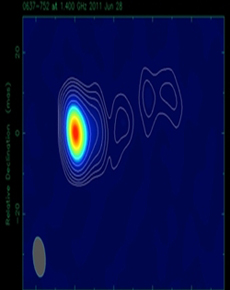Big step forward for NZ-Aust SKA telescope network

New Zealand and Australia’s bid to host the international SKA radio telescope has taken a leap forward, following the commissioning of a working optical fibre link between AUT University’s radio telescope and radio telescopes across Australia including CSIRO’s Australian SKA Pathfinder (ASKAP) telescope in Western Australia.
The achievement is being announced at the 2011 International SKA Forum, taking place this week in Banff, Canada.
On 29 June, radio astronomers used six telescopes — AUT’s at Warkworth, ASKAP, three more CSIRO telescopes in NSW and a telescope of The University of Tasmania — together to observe a radio source that may be two black holes orbiting each other.
Data from all sites were streamed in real time to Curtin University in Perth and processed to make an image.
This ability to successfully link antennas (dishes) over large distances is vital for the future $2.5 billion SKA telescope, which will have several thousand antennas, up to 5,500 kilometres apart, working together as a single telescope. Linking antennas in such a manner allows astronomers to see distant galaxies in more detail.
"We now have an SKA-scale network in Australia and New Zealand: a combination of CSIRO and NBN-supported fibre and the existing AARNETT and KAREN research and education networks," says Dr Brian Boyle, SKA Director for Australasia.
AUT’s Professor Sergei Gulyaev says, “SKA’s thousands of dishes will produce so much information per second that recording over many hours would be simply impossible. Instead we will have to stream and process vast amounts of data in real-time. This is 21st century technology and we are proud that New Zealand is at the very forefront of this development.”
The radio astronomers targeted PKS 0637-752, a quasar more than twelve thousand million light years away.It emits a spectacular radio jet with regularly spaced bright spots in it, like a string of pearls. Some astronomers have suggested that this striking pattern is created by two black holes in orbit around each other, one black hole periodically triggering the other to “feed” and emit a burst of radiation.
“It’s a fascinating object, and we were able to zoom right into its core, seeing details just a few millionths of a degree in scale, equivalent to looking at a 10 cent piece from a distance of 1,000 km” says CSIRO astronomer Dr Tasso Tzioumis.
During the experiment radio astronomers controlled all the telescopes over the Internet from Warkworth and Sydney.
Professor John Raine, Chair of REANNZ says, “SKA-like real-time observations are a great achievement by New Zealand and Australian researchers. KAREN which provides the data network for New Zealand’s research insitutions intends to be an anchor tenant on a new international cable that, if built, will provide international connectivity of 40 Gbps by 2014, scaling through 80Gbs in 2017 to 160Gbsby 2022 – more than enough to link the New Zealand and Australian parts of SKA.”